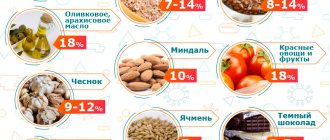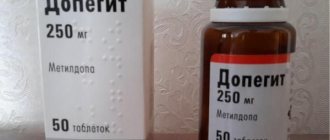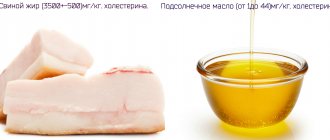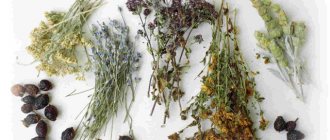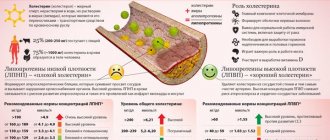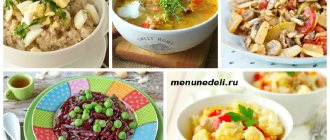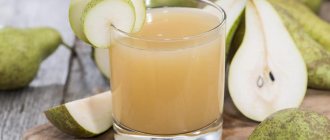According to WHO, every fifth person on the planet who has reached the age of 45 suffers from atherosclerosis. This is a disease associated with a disorder of fat metabolism in the body, in which cholesterol plaques form on the walls of blood vessels. The pathology is especially dangerous due to its complications: acute death of the heart muscle (myocardial infarction) and brain tissue (stroke).
Typically, therapy for atherosclerosis includes long-term use of medications from the group of statins, which have their own side effects and are quite expensive. But few people know that some foods also contain cholesterol-lowering substances. Is it possible to replace medicinal statins with natural ones? Will this help normalize fat metabolism in the body, and what do you need to know when stopping taking pills?
Mechanism of action of statins in hypercholesterolemia
It is known that up to 80% of all cholesterol circulating in the blood is synthesized in liver cells (the remaining 20% comes with food). This fatty alcohol is necessary for the body to build cell membranes and synthesize steroid hormones. An increase in its production in the liver, along with excess intake into the body, are important factors in the formation of atherosclerosis.
The mechanism of action of statins in hypolipidemia is well studied: the drugs inhibit the activity of the enzyme HMC-CoA reductase and significantly reduce the production of endogenous cholesterol by liver cells. Normalization of fat metabolism is necessary to stop the formation of cholesterol plaques and prevent acute cardiovascular pathology.
Advantages of drugs from the statin group:
- Reduce mortality from heart disease by 40% during the first 5 years of use.
- Reducing the risk of heart attack or stroke by a third.
- Reducing the concentration of cholesterol in the blood by 45-50% with regular use.
- Safety – modern statins rarely cause side effects.
- A variety of drugs with identical active ingredients.
To monitor cholesterol reduction, all patients taking statins are recommended to have monthly blood tests to determine their lipid profile.
However, cholesterol-lowering drugs also have significant disadvantages:
- The need for long-term use - statins are often prescribed to patients with dyslipidemia for a course of several months or even years.
- The high cost of modern representatives of the group.
- There is conflicting evidence about the need to take statins: there are studies showing the negative impact of low cholesterol on the body.
- The development of undesirable effects with long-term use in 2-3% of patients: muscle weakness, rhabdomyolysis - acute muscle necrosis, memory impairment, insomnia, neuropathy, emotional lability, irritability, sudden mood swings.
Thus, statins for cholesterol are not a panacea, and their use is often inconvenient for patients with dyslipidemia. Let's consider what can replace these drugs, what foods contain natural substances that help lower cholesterol, and whether it is possible to stop taking pills altogether for atherosclerosis.
Many familiar products contain substances that restore impaired lipid metabolism. So-called natural statins are products whose regular consumption leads to a decrease in blood cholesterol levels. They are an excellent alternative to pharmaceutical drugs in the treatment of mild to moderate atherosclerosis.
What are they?
Natural elements are used as an alternative to drugs, the mechanism of action of which is similar. Many patients have contraindications to the use of statin medications. These drugs also have a large list of side effects, which is dangerous for older people. Therefore, the use of products as a source of anticholesteric substances has a positive effect on the treatment of atherosclerosis. These include certain vegetables and fruits, plants, and grains.
But this does not mean that with their help you can completely abandon medications, since they reduce indicators by 10-20%, so their use must be approved by a doctor.
Vegetables and fruits
Fresh vegetables, fruits and berries are a source of vitamins, microelements and fiber. They should form the basis of the diet of patients with lipid metabolism disorders, since:
- normalize the functioning of the gastrointestinal tract and prevent the absorption of harmful substances in the intestines;
- cleanse the blood of toxins and harmful substances, remove toxins from the body;
- due to the high content of vitamins and antioxidants, they protect the walls of blood vessels from the formation of cholesterol plaques;
- directly reduce cholesterol concentrations - LDL (low density lipoproteins).
Apples
Apples are record holders for the content of pectin, vitamin B3 and ascorbic acid. These fruits help normalize metabolism, protect the vascular wall from damage, and reduce cholesterol levels.
According to a study conducted by the American Association against Atherosclerosis, eating 1 apple daily reduces cholesterol levels by 15-20%.
Citrus fruits and berries
The sour pulp of citrus fruits contains a large amount of antioxidants. Including oranges, lemons or tangerines in your daily diet will strengthen your immune system, restore impaired metabolism and lipid balance. Due to their saturation with vitamin C, citrus fruits prevent the formation of atherosclerotic plaques and contribute to the destruction of already formed cholesterol deposits.
Ripe and sweet lingonberries and black currants are an irreplaceable source of polyphenols. These biologically active substances increase the level of antiatherogenic lipoproteins, and are successfully used both for the prevention and complex treatment of atherosclerosis.
Grapes, especially red varieties, contain large amounts of resveratrol, a powerful antioxidant that can be classified as a natural statin. Resveratrol prevents the formation of damage to the vascular wall and the formation of atherosclerotic plaques. Grape juice or red wine (but no more than 1 glass per day) is an effective natural remedy for the prevention of cardiovascular diseases. Oil is produced from grape seeds, which contain large amounts of unsaturated fatty acids. It is also recommended to include it in your diet for patients with atherosclerosis.
White cabbage, garlic and bell pepper
Cabbage, familiar to everyone, can replace pharmaceutical drugs, as it helps eliminate LDL and VLDL from the body. If there is a violation of fat metabolism, you can use it in any form - stewed, pickled, boiled in first courses and side dishes, but the most useful is still a fresh vegetable.
Patients with atherosclerosis are also recommended to consume garlic daily, which is rich in essential oils, antioxidants and substances that accelerate metabolism. Due to its local irritant effect, the product is contraindicated in acute and chronic gastrointestinal diseases.
Pepper is a vegetable with the highest content of vitamin C. Its regular consumption leads to strengthening of vascular walls, normalization of metabolism and prevention of atherosclerosis.
Mushrooms
Mushrooms are also useful for disorders of fat metabolism, containing large quantities of calcium and potassium, which strengthen the walls of blood vessels, vegetable protein, which saturates the body with energy during a low-calorie diet, as well as vitamins D and B3, necessary for reducing “bad” cholesterol. Mushrooms have pronounced anti-inflammatory properties that help defeat atherosclerosis in the early stages of the disease.
Jerusalem artichoke
Jerusalem artichoke is an unforgivably rare vegetable that appears on our tables. It is an excellent assistant in the fight against high cholesterol due to the content of pectin and plant fiber. The juice and pulp of the root vegetable is used to restore motility of the digestive tract, reduce cholesterol levels and prevent cardiovascular and cerebral disorders of atherosclerosis.
Experts also call natural statins among vegetables and fruits:
- grapefruit;
- avocado;
- pomegranate;
- blueberries;
- carrot;
- broccoli.
By diversifying their daily diet with dishes made from fresh vegetables and fruits, patients with atherosclerosis achieve excellent results: within the first three months of such a diet, cholesterol levels can decrease by 10-15% from the original level.
Natural statins for cholesterol – how to recover naturally?
Diet food
A new study conducted by David Jenkins (professor of nutrition at the University of Toronto), who created the "glycemic index concept", observed volunteers who followed a special diet . It harmoniously combined products that are guaranteed to lower cholesterol levels (so-called natural statins):
- soy proteins such as tofu and soy milk;
- water-soluble fiber from oats and barley;
- vegetable oil enriched with sterol ester;
- and tree nuts such as almonds and walnuts.
Over 6 months, all participants' LDL levels dropped by at least 13%, which is comparable to statins and much better than a traditional low-fat diet. In addition, Houston recommends the (proven) "Mediterranean diet," which emphasizes protein and healthy fats such as fish and extra virgin olive oil, as well as plenty of fiber-rich foods (6 vegetable and 4 fruit servings per day ).
Move more!
Special physical exercises (for the cardiovascular system) will strengthen your heart, raise “good” cholesterol and lower the level of “bad” cholesterol. Start small: first with a walk in the park. Then switch to slow running, swimming or cycling for up to 20 minutes a day. Combining this with 40 minutes of daily gymnastics.
Gradually work your way up to longer sessions, 4 times a week, says Houston. Your main goal: get rid of visceral abdominal fat (for example, around the waist), a major risk factor. If you smoke, quit right away!
Smoking increases the amount of bad cholesterol in the blood and decreases the amount of good cholesterol, which is the most important risk factor for the development of heart disease.
Give up unhealthy fats forever
Avoid trans fats, which lower HDL levels and raise LDL levels. Most often they are found in processed foods and baked goods, which even have an inscription in the spirit of “no harmful substances.”
A loophole in food industry regulations allows 0.5 grams of trans fat per serving of a product to be considered safe for health.
But the problem is that if you eat more than 1 serving or more than 1 type of similar food, you will end up getting a bad dose of harmful elements. Too much saturated fat is found in animal products such as red meat and butter. They can also negatively affect your cholesterol levels, so significantly reduce your intake.
Eat more fatty fish
Research shows that EPA and DHA, omega-3 fatty acids found in fish such as salmon, mackerel and sardines, reduce triglycerides. They also reduce systemic inflammation. Scientists believe that these components effectively counteract the negative effects of inflammatory substances in the body such as prostaglandins and macrophages.
Recommended: at least 2 full servings of fatty fish per week! If you don’t eat fish (allergy, can’t stand the smell, or for other good reasons), then take fish oil. An excellent alternative to healthy seafood is flaxseed oil, a fairly powerful natural statin that also fights inflammation thanks to ALA (another fatty acid).
Turn away from carbs and sugar
In a review of more than 200 trials, scientists showed that eating foods high in the glycemic index (such as white potatoes, sugar, white rice and white bread) increases the risk of atherosclerosis. Along with powdered sugar, these products cause inflammation and form harmful small LDL particles (which we wrote about above).
Choose fiber-rich whole grains and nature's goodness, such as raspberries and pears (delicious natural statins).
Enjoy dark chocolate. According to recent research, antioxidant flavonoids in cocoa can reduce the oxidation of bad cholesterol, and dark chocolate, which is high in polyphenols, increases good cholesterol levels. Most chocolate products also contain saturated fat.
Enjoy red wine, tea and curry.
Recent research has linked drinking red grape juice and very moderate amounts of red wine (up to about 8 ounces daily for men and 4 ounces for women) to improved heart health and a reduction in systemic inflammation. All this happens thanks to the powerful antioxidant resveratrol.
Green and black tea have the same effect: drink at least 3 cups a day to improve your LDL-to-HDL cholesterol ratio and reduce your risk of heart attacks.
And finally, completely new experiments have proven that the antioxidant (and antidepressant) curcumin (or diferuloylmethane), obtained from turmeric root (“holy powder” as the Indians themselves call it), perfectly prevents the development of atherosclerosis. And even slows down cancer, having an anti-inflammatory/anti-tumor effect!
Spices, herbs and medicinal plants
Surprisingly, many people have an excellent “cure” for cholesterol growing in their gardens. Fresh greens and herbs contain a large amount of biologically active substances that help fight atherosclerosis.
Parsley
Parsley is a source of natural statins - antioxidants, plant fiber, vitamin C and carotenoids. If you regularly add fresh greens to salads, first and second courses, you can increase the level of “good” cholesterol and significantly reduce the risk of the formation of atherosclerotic plaques.
Celery
The unique composition of celery, rich in vitamins, microelements, fiber and choline, allows it to be used as an effective means for the prevention of atherosclerosis. Both the stems and rhizomes of the plant are suitable for food, as they can reduce LDL levels by 5-10% of the original level and normalize metabolism.
Turmeric
Turmeric is perhaps the most useful spice for people suffering from atherosclerosis. The golden powder contains a unique substance, curcumin, which transports atherogenic, “bad” cholesterol to the liver, converts it into bile and excretes it from the body.
To prevent and treat lipid metabolism disorders, doctors recommend adding a pinch of turmeric to first and second courses daily.
Herbs and medicinal plants
Herbal treatment, or herbal medicine, is a large section of traditional medicine. According to this teaching, biologically active components contained in medicinal plants can quickly and effectively establish lipid metabolism.
How to replace pharmaceutical drugs to lower cholesterol? Experts identify several medicinal plants:
- sage;
- wormwood;
- dandelion;
- yarrow;
- Rowan;
- plantain seeds;
- dog-rose fruit;
- Rowan.
These plants are rich in natural statins, vitamins and antioxidants, have mild choleretic properties, help reduce body weight and restore digestion.
Most often, an infusion of medicinal herbs is used to prevent and treat high cholesterol. To prepare it, you need to mix fresh or dried medicinal plants in equal proportions, pour 1 tablespoon of the resulting mixture into two glasses of boiling water and leave for at least two hours. Then the infusion is filtered through a sieve or gauze folded in several layers and drunk 100 ml 3 times a day (before meals). The course of treatment is 1-2 months.
Note! The use of any traditional medicine recipes must be agreed with the attending physician. This infusion is contraindicated in case of individual intolerance, allergies, cholelithiasis and chronic kidney disease.
Polyunsaturated fatty acids as natural statins
It is known that all the fat contained in food is divided into harmful, which promotes the growth of “bad” cholesterol and the formation of atherosclerotic plaques, and beneficial, which reduces HDL levels and restores lipid balance.
If the consumption of the former (its maximum content in animal fat - offal, lard and fatty meat, milk, cream, cheese, egg yolks) in case of atherosclerosis is recommended to be sharply limited, then you should try to include dishes that contain healthy lipids in your daily diet .
What makes products useful for the body is the high content of polyunsaturated fatty acids - active participants in lipid metabolism, which capture the “bad” fractions of cholesterol - LDL and VLDL and deliver them to the liver for further processing and excretion through the intestines. Since atherosclerosis typically causes an increase in LDL and a decrease in beneficial HDL, it is important to increase levels of the latter to restore balance.
Foods rich in polyunsaturated fatty acids include:
- Unrefined vegetable oils: pumpkin, peach, olive, flaxseed.
- Fatty sea fish: sardine, mackerel, salmon, herring.
- Flaxseed is a unique medicinal product that is successfully used for the complex treatment of not only atherosclerosis, but also diseases of the digestive system, as well as normalization of body weight and metabolism.
Natural statins in food
Many natural substances not only reduce LDL, but also increase HDL (good) and lower triglycerides (fats).
Soybeans
Drugs for normalizing cholesterol levels can be replaced with this product - the so-called analogue of a tablet statin - soy.
A subtropical natural plant native to Asia and a member of the pea family. It has been a dietary staple in Eastern countries for thousands of years and is considered an excellent source of protein and fiber. There is compelling evidence of its effectiveness. Avoid soy if you have an allergy or sensitivity to it or breast, ovarian, or uterine cancer.
Cereals, nuts and legumes
Dishes made from whole grains, nuts and legumes should always be present in everyone's diet. These products can also be called natural statins because they:
- contain fiber, which cleanses the intestines and removes impurities, toxins and other harmful substances from the body;
- contribute to the normalization of body weight and metabolism;
- reduce LDL synthesis in liver cells and cause a decrease in its concentration in the blood;
- prevent the formation of atherosclerotic plaques;
- saturate the body with all the necessary nutrients (including high-quality plant protein), allowing you to feel full even on a low-calorie diet.
Cereal porridges are traditionally considered an excellent option for breakfast, as they do not overload the gastrointestinal tract, but at the same time provide all the body’s energy needs. The following are considered especially useful for atherosclerosis:
- buckwheat grain;
- Wheat groats;
- rice cereal;
- oatmeal and oatmeal.
Despite the fact that nuts are quite high in calories, in small quantities they are recommended for patients with impaired lipid metabolism as an additional source of healthy unsaturated fatty acids. Pistachios (in medical nutrition it is better to use unsalted ones) reduce the absorption of cholesterol from food in the intestines, and peanuts help restore the imbalance between LDL and HDL.
Legumes (peas, beans, soybeans and soy products) are an important source of complete plant protein for patients with atherosclerosis. The lack of animal fats and satiety make them indispensable for people on a diet.
Doctors' recommendations
Doctors do not recommend taking statins in all cases. Thus, experts advise patients of reproductive age, regardless of gender, to primarily reduce cholesterol levels by maintaining a balanced diet and adjusting their lifestyle. However, this option is suitable for those whose blood cholesterol levels are not critically high. If the level of this substance is so high that it threatens the development of irreversible consequences for the cardiovascular system, the doctor decides to prescribe medications, including statins.
